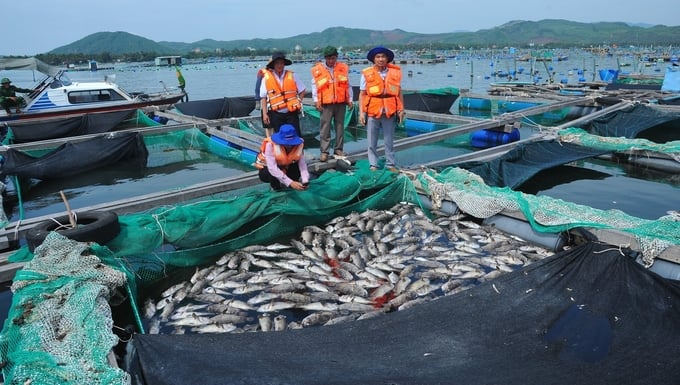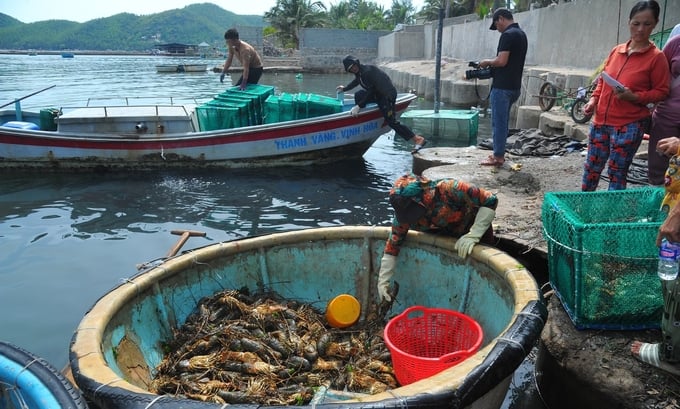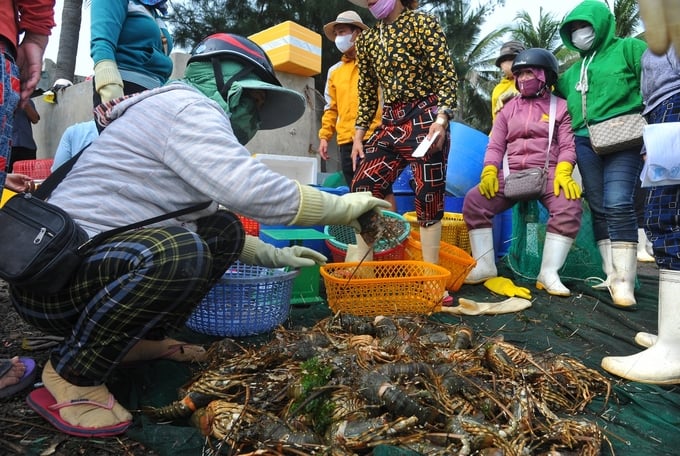Lobster and fish died in the farming area of Song Cau town (Phu Yen province) not due to disease but due to lack of oxygen in the farming area.
Farmers in Song Cau town, Phu Yen province suffered heavy losses due to mass deaths of lobsters and fish. Image: AN.
The stocking density is too thick
The Institute for Aquaculture Research III (referred to as Institute III) has just released a survey report on supporting Phu Yen province in determining the causes of lobster and marine fish deaths. Accordingly, on May 22, Institute III sent a working delegation to Vinh Hoa and Phu Duong villages in Xuan Thinh commune (Song Cau town), where lobsters and fish died in large numbers to survey, measurements and sample collection.
Survey results, Institute III found that the farming area with dead lobsters and fish is located in the back beach area of Vinh Hoa and Phu Duong villages with a narrow bay opening to the sea (Cu Mong lagoon mouth) and more than 11,000 cages of lobster, sea fish of all kinds.
The farming cage is a submerged cage, with an iron frame covered with mesh, measuring 2.5 x 2.5 x 1 m, placed in the farming area with a depth of 4 – 5m when the water is high and 3 – 4m when the water is low.
The cage is “framed” off the bottom by 20 liter plastic drums and cans; The cage is about 0.5 – 1.0m from the bottom; The distance between cages is from 0.8 – 1.5m, the shrimp stocking density is from 100 – 200 shrimp/cage.
Authorities took samples of dead lobsters for testing and did not detect the causative agent of milk disease. Image: AN.
According to Institute III’s assessment, the number of such cages per unit area is too thick, causing poor water circulation. Furthermore, the cages placed in the farming area are at a lower depth than prescribed (6m when water is low). In addition, the muddy bottom has a foul smell and many mollusc shells are 0.4 – 0.6m thick.
During the survey, the team also observed the phenomenon of sea eels and marine fish of all kinds dying in the survey area.
Measurement of water parameters at the site found that the dissolved oxygen (DO) content was not suitable for lobster and marine fish farming at the time of the survey. Specifically, at low water time in Vinh Hoa village (lagoon mouth), dissolved oxygen was 0.64mg/l (bottom layer) and 0.76mg/l (surface layer). In Phu Duong village, dissolved oxygen is 1.42mg/l (bottom layer) and 2.7mg/l (surface layer).
While the water is high in Vinh Hoa village, dissolved oxygen is 5.06mg/l (bottom layer) and 5.27mg/l (surface layer; in Phu Duong village, dissolved oxygen is 2.20mg/l (bottom layer) and 2. 54mg/l (surface layer). In addition, the water temperature measured ranged from 28.8 – 30.8 degrees Celsius, higher than the same period last May.
From the survey results, Institute III recommends immediate solutions to avoid damage to farmers in Song Cau town as follows: Move or reduce the number of cages per unit area. During the cage transportation process, be careful to avoid shocking lobsters and sea fish. At the same time, the number of lobsters and sea fish that have reached commercial size is harvested. Raise the cages that no longer have lobsters or farmed marine fish out of the water to increase water circulation during high water and low water (high tide, low tide) as well as raise the cages close to the water surface and shade the cages, and proactively prepare aerators, oxygen tanks/oxygen granules in case farmed lobsters and marine fish suffocate due to local low oxygen.
Damage over 38 billion VND
According to the People’s Committee of Song Cau town, as of 3:00 p.m on May 23, 67 tons of lobster and 62 tons of sea fish from 281 farming households in communes and wards including Xuan Thinh, Xuan Canh, Xuan Dai, and Xuan Thanh have died, estimated damage of more than 38.4 billion VND.
By 3:00 p.m on May 23, farmers in Song Cau town had lost more than 38 billion VND. Image: AN.
From the monitoring results of taking water samples, farmed shrimp and fish samples, the People’s Committee of Song Cau town on May 23 issued a document directing the People’s Committee of Xuan Thinh commune to propagate and popularize aquaculture farmers about the causes of lobster, marine fish have died recently not due to the spread of disease but due to lack of oxygen in the farming environment. The reason is due to the persistent hot weather, combined with low water, when the water is large, it cannot enter the farming area, so it cannot create a flow, further reducing the ability to dissolve oxygen into the water.
For current farming areas, aquaculture farmers are relocating temporary cages and rafts to avoid environmental impacts. Farmers should be advised to arrange the cages occasionally, ensuring a density of 30 – 60 cages/ha.
In addition, in the farming areas in the villages of Vinh Hoa, Phu Duong, Hoa Hiep (Xuan Thinh commune), the cage density is too thick, hindering water circulation and is the main cause of lowly dissolved oxygen phenomenon in recent times, requiring farmers to raise cages without aquatic products above the water surface (on rafts) or bring them to shore to create clear flow for the entire Cu Mong lagoon.
Institute III recommends that farmers should regularly collect shrimp and fish that die in the wild, waste, and excess food and take them out of the water bodies in the farming area. Closely monitor developments in the situation of lobsters and marine fish farmed 24/7 and the weather situation in the near future to have timely solutions, especially during times of low water at night.
Kim Sơ



